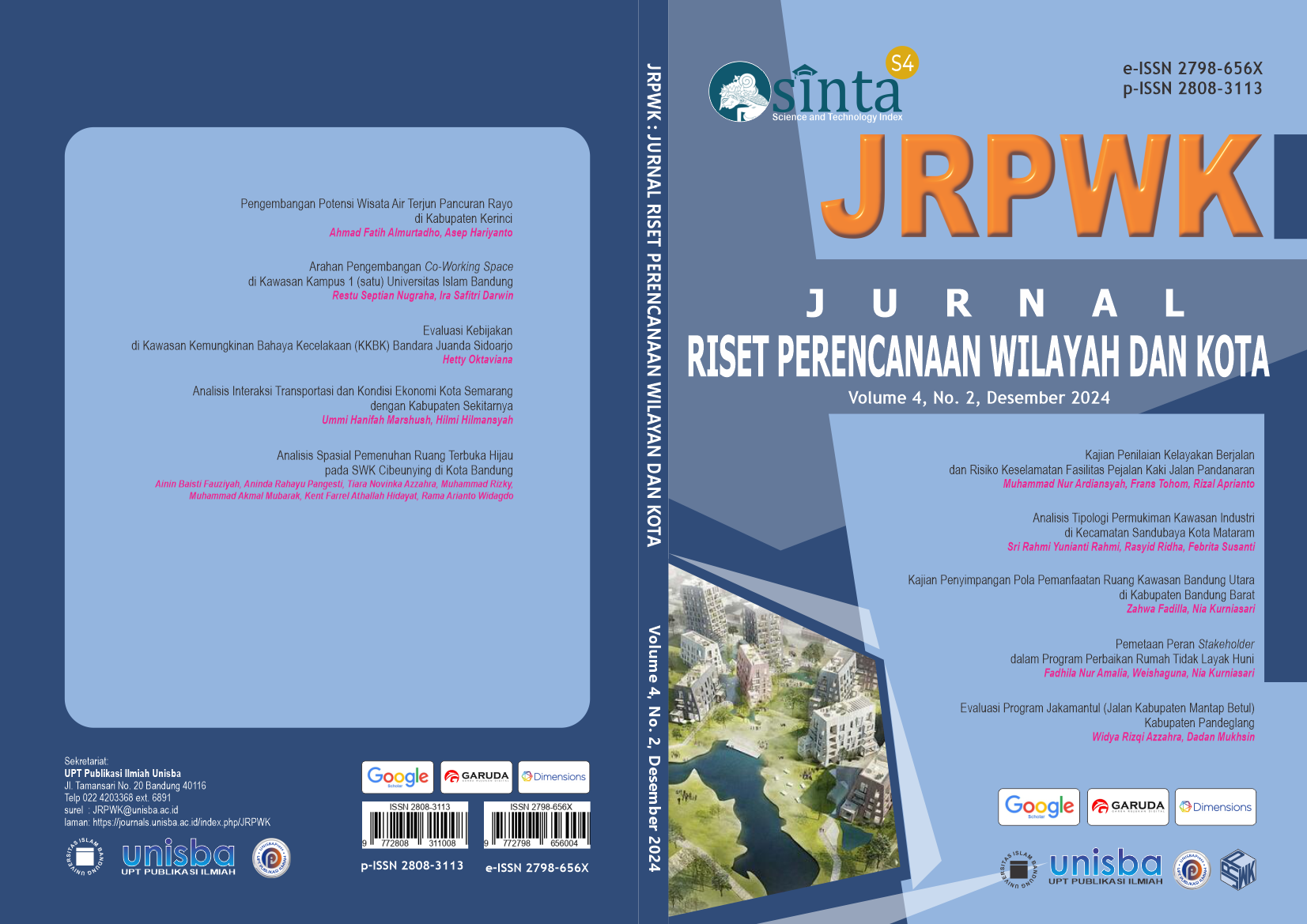Evaluasi Kebijakan di Kawasan Kemungkinan Bahaya Kecelakaan (KKBK) Bandara Juanda Sidoarjo
DOI:
https://doi.org/10.29313/jrpwk.v4i2.5453Keywords:
PSZ, KKBK (Kawasan Kemungkinan Bahaya Kecelakaan), KebijakanAbstract
Abstrak. Penelitian mengenai Kawasan Kemungkinan Bahaya Kecelakaan (KKBK) memiliki urgensi tinggi, terutama dalam konteks keselamatan penerbangan dan pengelolaan ruang udara di Indonesia. Hal ini mengingat fakta empiris yang menunjukkan mayoritas kecelakaan terjadi selama fase pendaratan dan pendekatan penerbangan, terhitung 76% dari total kecelakaan[1]. Penelitian ini bertujuan untuk mengevaluasi kebijakan pemerintah terkait aturan KKBK. Metodologi content analysis dan overlay GIS. Hasil penelitian ini menyimpulkan pertama, Kebijakan RTRW masih bersifat umum untuk membahas KKBK. Kebijakan yang ada masih membahas sebatas KKOP. Kedua, perlunya menampilkan radius KKBK dalam peta rencana pola ruang. Ketiga, terdapat inkonsistensi antara aturan KKBK Rencana Induk Bandar Juanda[2] dengan RTRW[3]Ketiga, perlunya memuat substansi penggunaan lahan KKBK yang detail.
Abstract. Research regarding Possible Accident Hazard Areas (KKBK) has high urgency, especially in the context of aviation safety and air space management in Indonesia. This is considering the empirical facts that show the majority of accidents occur during the landing and approach phases of flight, accounting for 76% of total accidents [1]. This research aims to evaluate government policies regarding KKBK regulations. GIS content analysis and overlay methodology. The results of this research conclude firstly, the RTRW Policy is still general in discussing KKBK. The existing policy still only discusses KKOP. Second, it is necessary to display the KKBK radius in the spatial pattern planning map. Third, there is an inconsistency between the KKBK regulations for the Bandar Juanda Master Plan [2] and the RTRW[3]. Third, there is a need to include detailed KKBK land use substance.
References
A. Cardi, P. Di Mascio, M. Di Vito, and C. Pandolfi, “Distribution of Air Accidents Around Runways,” Procedia Soc Behav Sci, vol. 53, pp. 861–870, Oct. 2012, doi: 10.1016/j.sbspro.2012.09.935.
“Keputusan Menteri Perhubungan Republik Indonesia Nomor KP 1023 Tahun 2018 Tentang Rencana Induk Bandar Udara Internasional Juanda di Kabupaten Sidoarjo Provinsi Jawa Timur,” 2018.
“Perda Kabupaten Sidoarjo No.4 /2024 Tentang RTRW Kabupaten Sidoarjo 2024-2044,” 2024.
“Undang-Undang Republik Indonesia Nomor 1 Tahun 2009 Tentang Penerbangan,” 2009.
P. A. Davies and O. J. Quinn, “Airport Public Safety Zones: Part 2-Risk Model Application.”
B. Laufenberg, “Statistical Summary of Commercial Jet Airplane Accidents,” 2024.
J. Ahmad, “Desain Penelitian Analisis Isi (Content Analysis),” 2018, doi: 10.13140/RG.2.2.12201.08804.
Titan Kesuma Endasmoro and Lely Syiddatul Akliyah, “Analisis Kesesuaian Pemanfaatan Ruang di Kecamatan Cianjur,” Jurnal Riset Perencanaan Wilayah dan Kota, pp. 39–46, Jul. 2023, doi: 10.29313/jrpwk.v3i1.1948.
Z. Oі, “Safety Risk As A Tool For Public Safety Zones Assessment Around The Runways,” Kyiv Ukraine, Dec. 2016.
L. Attaccalite, P. Di Mascio, G. Loprencipe, and C. Pandolfi, “Risk Assessment Around Airport,” Procedia Soc Behav Sci, vol. 53, pp. 851–860, Oct. 2012, doi: 10.1016/j.sbspro.2012.09.934.
P. Di Mascio, G. Perta, G. Cantisani, and G. Loprencipe, “The public safety zones around small and medium airports,” Aerospace, vol. 5, no. 2, Apr. 2018, doi: 10.3390/aerospace5020046.
L. Mitsevich and N. Zhukovskaya, “Geospatial modeling, analysis and mapping for aerodrome land development,” in E3S Web of Conferences, EDP Sciences, Oct. 2021. doi: 10.1051/e3sconf/202131004003.
A. Latif GALYounes, A. E. A Mostafa, M. El-SadekOuf, S. M. Noureldin, and S. M. Ismail AbdElhady, “Study the compatibility of land uses surrounding international Airports (Case Study: Hurghada International Airport),” African J. Biol. Sci, vol. 16, no. 1, pp. 245–267, 2020, [Online]. Available: www.ajbs.journals.ekb.eg
A. L. .Younes, A. Mostafa, M. Ouf, S. Noureldin, and S. AbdElhady, “Towards compatible land use planning around public airports (Applied case study: Marsa Alam International Airport),” International Journal of Development, vol. 9, no. 1, pp. 45–65, Dec. 2019, doi: 10.21608/idj.2019.194001.
“Standar Nasional Indonesia (SNI) 03-7112-2005 Tentang Kawasan Keselamatan Operasi Penerbangan, 2005,” 2005.
“Peraturan Menteri Perhubungan RI No. PM 55 Tahun 2023 Tentang Tata Cara dan Prosedur Penetapan Lokasi Bandar Udara dan Tempat Pendaratan Dan Lepas Landas Helikopter,” 2023.
M. Rosario Contreras-Alonso, A. Ezquerra-Canalejo, E. Pérez-Martín, T. R. Herrero-Tejedor, and S. L. C. Medina, “Environmental assessment of Obstacle Limitation Surfaces (OLS) in airports using geographic information technologies,” PLoS One, vol. 15, no. 2, 2020, doi: 10.1371/journal.pone.0229378.
Abizar Aria Ghifar, I. Safitri, and I. Fardani, “Pemantauan Progres Pemanfaatan Ruang Kawasan Prioritas RDTR Perkotaan Singaparna Menggunakan UAV,” Jurnal Riset Perencanaan Wilayah dan Kota, vol. 1, no. 1, pp. 1–6, Jul. 2021, doi: 10.29313/jrpwk.v1i1.71.
Environmental Resources Management (ERM)., “Public Safety Zones: Criteria and Policy, Risk Assessment and Expert Opinions,” Feb. 2005. Accessed: Nov. 25, 2024. [Online]. Available: assets.gov.ie
B. A. C. da Silva, G. S. Santos, and R. de A. Gomes, “Land use policy in the vicinity of airports: Analysis and lessons learned from the Brazilian situation,” Land use policy, vol. 90, Jan. 2020, doi: 10.1016/j.landusepol.2019.104314.
Downloads
Published
Issue
Section
License
Copyright (c) 2024 Hetty Oktaviana

This work is licensed under a Creative Commons Attribution-NonCommercial-ShareAlike 4.0 International License.















